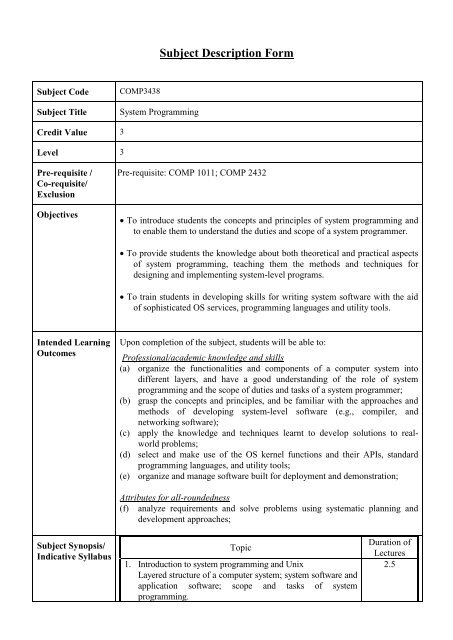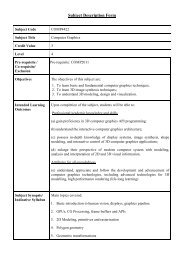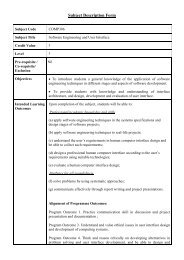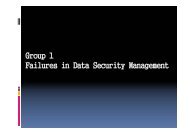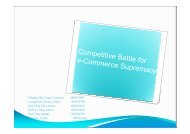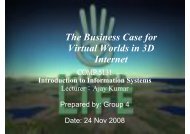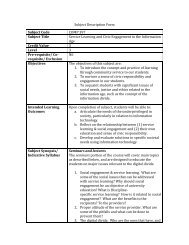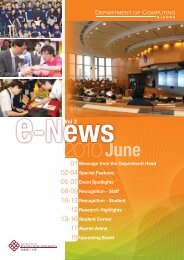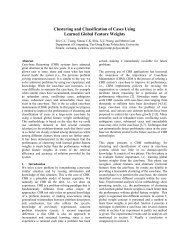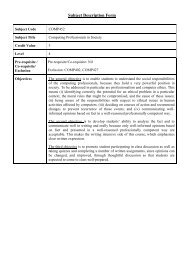COMP3438 System Programming
COMP3438 System Programming
COMP3438 System Programming
You also want an ePaper? Increase the reach of your titles
YUMPU automatically turns print PDFs into web optimized ePapers that Google loves.
Subject Description Form<br />
Subject Code<br />
Subject Title<br />
<strong>COMP3438</strong><br />
<strong>System</strong> <strong>Programming</strong><br />
Credit Value 3<br />
Level 3<br />
Pre-requisite /<br />
Co-requisite/<br />
Exclusion<br />
Objectives<br />
Pre-requisite: COMP 1011; COMP 2432<br />
To introduce students the concepts and principles of system programming and<br />
to enable them to understand the duties and scope of a system programmer.<br />
To provide students the knowledge about both theoretical and practical aspects<br />
of system programming, teaching them the methods and techniques for<br />
designing and implementing system-level programs.<br />
To train students in developing skills for writing system software with the aid<br />
of sophisticated OS services, programming languages and utility tools.<br />
Intended Learning<br />
Outcomes<br />
Upon completion of the subject, students will be able to:<br />
Professional/academic knowledge and skills<br />
(a) organize the functionalities and components of a computer system into<br />
different layers, and have a good understanding of the role of system<br />
programming and the scope of duties and tasks of a system programmer;<br />
(b) grasp the concepts and principles, and be familiar with the approaches and<br />
methods of developing system-level software (e.g., compiler, and<br />
networking software);<br />
(c) apply the knowledge and techniques learnt to develop solutions to realworld<br />
problems;<br />
(d) select and make use of the OS kernel functions and their APIs, standard<br />
programming languages, and utility tools;<br />
(e) organize and manage software built for deployment and demonstration;<br />
Attributes for all-roundedness<br />
(f) analyze requirements and solve problems using systematic planning and<br />
development approaches;<br />
Subject Synopsis/<br />
Indicative Syllabus<br />
Topic<br />
1. Introduction to system programming and Unix<br />
Layered structure of a computer system; system software and<br />
application software; scope and tasks of system<br />
programming.<br />
Duration of<br />
Lectures<br />
2.5
Evolution of UNIX; features of UNIX; UNIX standards;<br />
good style of UNIX programming.<br />
2. Introduction to UNIX <strong>System</strong>s<br />
5<br />
Files; types of UNIX files; UNIX file system; structure and<br />
representation of files in UNIX file system; directories;<br />
accessing files in UNIX; I/O redirection; devices and device<br />
drivers; UNIX file interface (APIs).<br />
UNIX shell; UNIX process creations and execution; process<br />
management; parent and child processes; UNIX process<br />
interfaces (APIs).<br />
3. Introduction to Unix Device Driver<br />
2.5<br />
Device Drivers; design issues; types of device drivers; major<br />
components of a device driver.<br />
4. Device Driver Development<br />
7.5<br />
OS/Driver interface; internal operations of a device driver;<br />
structure and major components; address spaces and data<br />
transfer; typical character/block driver design and<br />
implementation.<br />
5. Overview of compiler construction<br />
2.5<br />
Syntax and semantics of programming languages; language<br />
translation approaches; tasks of a compiler; the compiler<br />
process.<br />
6. Lexical analysis<br />
5<br />
Tasks of lexical analysis; specifying tokens by regular<br />
grammars and regular expressions; recognizing tokens by<br />
Finite Automata (FA); construction of FA from regular<br />
expressions; converting NFA to DFA; simulating DFA.<br />
7. Syntax analysis<br />
7.5<br />
Tasks of syntax analysis; specifying language constructs by<br />
context-free grammars; BNF; derivation; parse and syntax<br />
trees; recognizing language constructs by Pushdown<br />
Automata; top-down and bottom-up parsing methods.<br />
8. Code generation<br />
2.5<br />
Intermediate compilation phases; symbol table; intermediate<br />
code generation; code optimization; code generation.<br />
Total 35<br />
Tutorials: 3 hours<br />
Laboratory Experiment:<br />
Topic<br />
1. UNIX system and C programming.<br />
2. UNIX programming (processes, files, device drivers).<br />
Duration of<br />
Laboratory<br />
2<br />
9<br />
Total 11<br />
Teaching/Learnin<br />
g Methodology<br />
In lectures, concepts, models and algorithms will be explained with illustrative<br />
examples.<br />
Tutorials and lab sessions help students understand concepts and improve their skills<br />
on solving problems.
Assignments help develop students’ programming skills and critical thinking.<br />
Assessment<br />
Methods in<br />
Alignment with<br />
Intended Learning<br />
Outcomes<br />
Specific assessment<br />
methods/tasks<br />
% weighting Intended subject learning outcomes to be<br />
assessed (Please tick as appropriate)<br />
a b c d e f<br />
1. Assignments 35% <br />
2. Mid-term 20% <br />
3. Examination 45% <br />
Total 100 %<br />
All three items are appropriate to evaluate the intended learning outcomes. Assignments<br />
are used to evaluate writing skills, critical thinking, and problem solving. Mid-term test<br />
and final examination can further help evaluate the related outcomes.<br />
Student Study<br />
Effort Required<br />
Class contact:<br />
• Lecture 35 Hrs.<br />
• Tutorial/Lab 14 Hrs.<br />
Other student study effort:<br />
• Assignments and self-study 63 Hrs.<br />
Reading List and<br />
References<br />
Total student study effort<br />
112 Hrs.<br />
Textbook:<br />
1. A.V. Aho, Monica S. Lam, R. Sethi and J.D. Ullman, “Compilers: Principles,<br />
Techniques, and Tools”, 2nd edition, Addison-Wesley, 2006.<br />
2. B. Molay, “Understanding Unix/Linux <strong>Programming</strong>”, Pearson Education,<br />
2003.<br />
3. G. Pajari, “Writing Unix Device Drivers”, Addison-Wesley Publishing<br />
Company, 1993.<br />
4. J. Corbet, A. Rubini, and G. Kroah-Hartman, “Linux Device Drivers”, 3rd<br />
edition, O'Reilly, 2005.<br />
Reference Books:<br />
1. W. R. Stevens and S. A. Rago, “Advanced <strong>Programming</strong> in the UNIX<br />
Environment ”, 2nd edition, Addison-Wesley, 2005.<br />
2. A.W. Appel, “Modern Compiler Implementation in Java”, Foundation Books,<br />
2007.<br />
3. K.C. Louden, “Compiler Construction: Principles and Practice”, PWS<br />
Publishing Company, 1997.<br />
4. L.L. Beck, “<strong>System</strong> Software: an Introduction to <strong>System</strong> programming”, 3rd<br />
edition, Addison Wesley, 1996.
5. K. Cooper and L. Torczon, “Engineering a Compiler”, Morgan Kaufmann,<br />
2003.<br />
6. J. Cooperstein, “Writing Linux Device Drivers: a guide with exercises”,<br />
CreateSpace, 2009.


